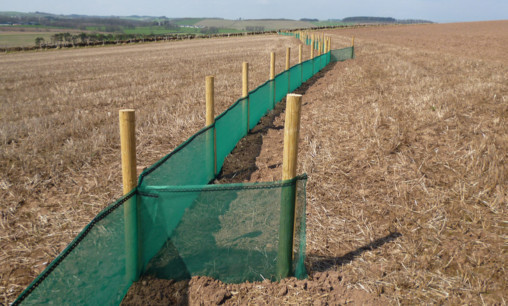Soil erosion can be a serious problem for those growing potatoes on sloping land. This is especially so during wet seasons such as have been recently experienced.
Apart from the loss of a valuable asset, there is also the risk that Single Farm Payments will be affected. Allowing soil to erode can be a serious breach of the need to keep land in good agricultural and environmental condition as defined in EU regulations.
James Hutton Institute principal catchment scientist Dr Andy Vinten told the Scottish Society of Crop Research winter potato meeting that one way of mitigating the problem was to erect sediment fences to trap water-borne soils before they left the field.
This would not stop the actual erosion, but at least the soil would be retrievable and could be spread back up the field when conditions allowed.
Dr Vinten had been approached by Richard Lockitt of Lockitt Environmental Services and his client Angus Bayne of Wester Gospetry Farm, Gateside, to see if he could monitor the effect of just such a fence.
Mr Bayne had one field in particular which had caused problems with soil being carried into the steading, necessitating an expensive clean-up.
In many cases, said Dr Vinten, the soil erosion was not so bad during the potato-growing season but could be a real problem post-harvest regardless of whether the field was left fallow or sown in winter crop.
He had noted that grubbing or heavy cultivating across the slope did little to reduce run-off, and even quite a wide buffer zone at the bottom of the field could be quite ineffective.
The plan at Wester Gospetry was to install around 100 metres of sediment fence. The material used was Terrastop Mono 60, a fine-meshed plastic material which allows water to filter through and leaves the sediment behind.
Standard round fence posts were used, with a single tensioned wire along the top of the fence to which the material was attached with the lower edge dug in. A five-metre buffer zone was left on the field side of the fence.
Critically, the fence line was run exactly along a contour. GPS technology was used to make sure the contour was followed to a tolerance of under an inch.
This meant there was an area of 0.2ha left inaccessible and fallow behind the fence.
Dr Vinten put the cost of the filtration membrane at around £1 per metre run, with the total cost including posts, erection and dismantling put at around £10 per metre.
He estimated that the material might last seven years, but much would depend on how carefully it was dismantled and stored.
“The 2013 summer was dry, of course, and there were no problems harvesting the crop, and conditions were equally good for sowing the winter cereals.
“There was no evidence of soil erosion in the autumn, but from mid-January this year until late February we had exceptionally wet conditions. This led to considerable erosion from the winter cereal field, mainly associated with tramlines.
“The result was several fans of sediment efficiently captured by the fence,” said Dr Vinten.
Using GPS technology again to measure the extent and depth of the deposits, it was estimated that 3.24 cubic metres of material had been captured.
The fact that there had been far less erosion than in previous years because of the dry conditions may have reduced the impact of the experiment, but Dr Vinten said he was satisfied with the technical efficiency of the fence and it had reduced the “anxiety factor” of managing a field which had peen problematic in the past.
Dr Vinten was hopeful that Scottish Rural Development Programme funding would be available to help pay for sediment traps of this sort and the creation of bunds.
If these could be integrated into greening measures such as buffer strips, detention ponds and wetlands, they could be part of the answer to diffuse pollution.
